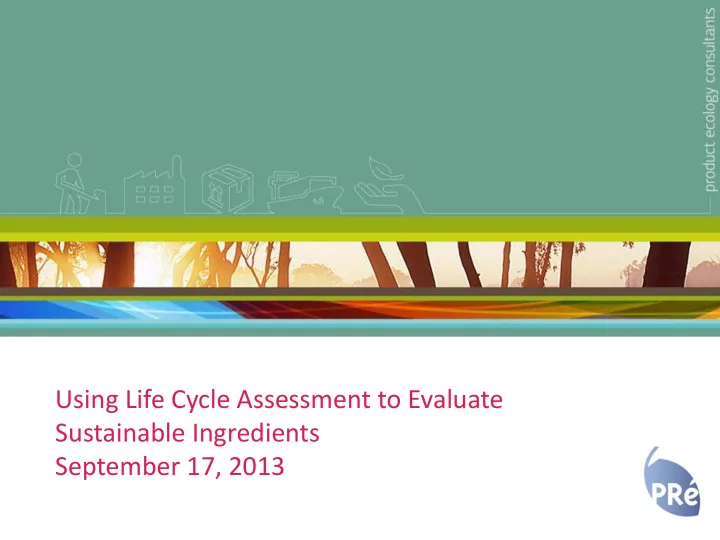

Using Life Cycle Assessment to Evaluate Sustainable Ingredients September 17, 2013
PRé Puts the Metrics behind Sustainability For over 20 years we have used our inherent industry knowledge to provide our clients with relevant sustainability metrics, mapping out a clear path to success. In more than 21 countries • Serving more than 2500 clients • Client industries ranging from • chemicals to retail to food & agriculture Primary offices • Washington, DC – Amersfoort, Netherlands – 2
What is LCA? Life cycle assessment is an environmental accounting methodology used to quantify and analyze the environmental performance of a product system. LCA can be part of the sustainability profile for systems and products. 3
The Basics • Life Cycle Inventory • Life Cycle Stages CO 2 21 g Raw Material N 2 0 10 g Extraction VOC 20 g P 2 g Disposal Processing Nitrate 20 g CH 4 8 g • Impact Assessment Use Distribution Global Warming Potential Retailing Ozone Depletion LCI Eutrophication Etc. 4
How are LCAs used? • Evaluate and identify hot • Compare products using a spots standardized methodology Disposal 100% 100% 90% 80% Use 80% 70% 60% 60% Retail 50% Product A 40% 40% Product B Distribution 30% 20% 20% 10% Processing 0% 0% Global Energy Ozone Global Warming Raw Material Warming Demand Depletion Potential Extraction 5
Example: Degussa – Emollient esters Impact Category Savings Energy 62% Global Warming 62% Acidification 88% Nutrient 74% enrichment Smog 76% Source: http://personal-care.evonik.com/product/personal-care/en/media- center/downloads/publications/Documents/biotimes-cosmetic-esters-made-by- 6 biocatalysis.pdf
Example: DuPont – Propanediol and propylene glycol 120 6 Non Renewable Energy (MJ/kg) GHG Emissions (kg CO2e/kg) 100 5 80 4 60 3 2 40 1 20 0 0 Bio-PDO Propanediol Propylene Bio-PDO Propanediol Propylene (PO Route) Glycol (PO Route) Glycol Source: http://www.duponttateandlyle.com/life_cycle 7
Evaluating Ingredients and Formulations Using Life Cycle Thinking 8
Value • Practically and systematically evaluate the environmental implications of ingredients • Compare ingredients and formulations using a standardized methodology • Build scenarios to answer what if questions • Use results to make decisions internally and communicate externally 9
Getting Started Consider your place in your supply chain and determine what type of analysis to use to evaluate ingredients and formulations. 10
Defining the Analysis • Palm Oil Esterification Emollients Soap • • • Corn Starch Coloring Agents Shampoo Hydrolysis • • • • Decyl Alcohol Hydrogenation Fragrances Lipstick • • • • Processes Ingredients Formulations Precursor Life Cycle Inventory Impact Assessment Results 11
Life Cycle Inventory Create LCI Impact Assessment Results Ingredients • Identify precursors • Identify processes Precursors Processes • Determine data availability ? ? ? ? ? ? ? ? ? ? ? ? ? ? ? ? ? ? ? ? 12
Life Cycle Inventory Create LCI Impact Assessment Results Ingredients • Secondary databases • Expert input Precursors Processes • Supplier Information • Extrapolation ? • Estimation ? ? ? ? ? • Proxies 13
Life Cycle Inventory Impact Assessment Impact Assessment Results Example Comparison Between Formulations 100 90 Ingredient A 80 Formulation 1 Ingredient B 70 60 Ingredient C Formulation 2 % 50 40 Ingredient D Formulation 3 30 Ingredient E 20 10 0 Global Energy Water Waste Warming 14
Simplified Screening Tool • Non-expert tool to quickly screen or rank ingredients for a defined set of impact categories • SimaPro Easy tool 15
Simplified Screening Tool 16
Life Cycle Simplified Screening Tool Inventory Results Impact Assessment Results 17
Advanced Screening Tool • In addition to screening, use of full life cycle models of product systems • More advanced analysis • SimaPro LCA software 18
Life Cycle Example Output- Advanced Inventory Screening Tool Impact Assessment Results 19
Utilizing Results Results Baseline Evaluate Identify Compare Compare Impacts for Individual Reduction Ingredients Formulations Product Groups Ingredients Opportunities 20
Life Cycle Inventory Utilizing Results Impact Assessment • Rank ingredients and formulations based on Results environmental impact • Additional ingredients can be added over time Product A High Impact Ingredient 2 Ingredient 3 Ingredient 1 Global Low Impact Energy Water Waste Warming 21
Conclusions: Improved Decision-Making Through LCA • Internal uses – Scenario building – Process evaluation – Performance quantification • External uses – B2B or B2C communication – Respond to customer inquiries – Identify new business opportunities 22
Questions 23
J. Renée Morin Name President, PRé North America, morin@pre-sustainability.com Job Title| <lastname>@pre-sustainability.com
Recommend
More recommend